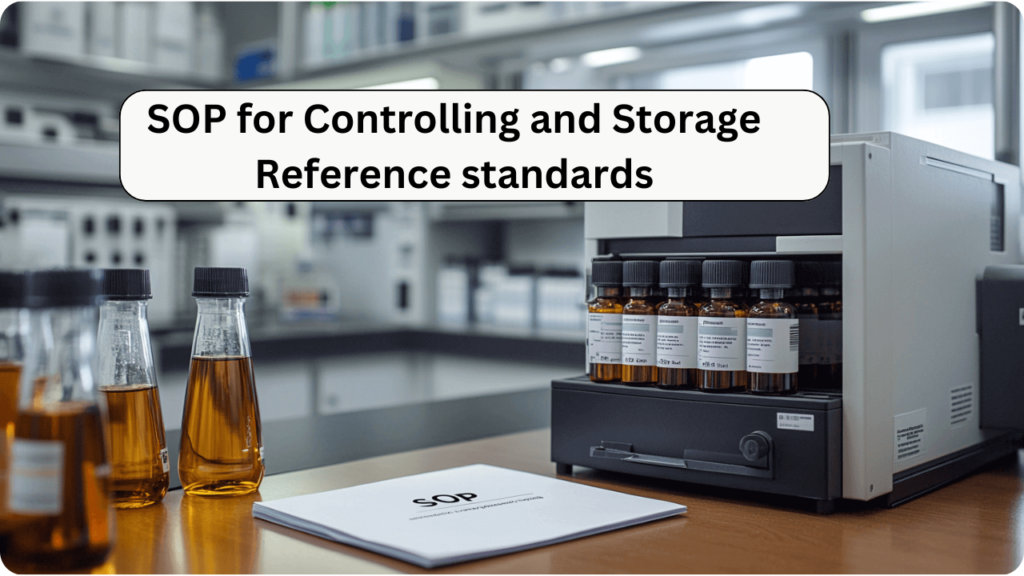Learn about Standard operating procedures for Controlling and Storage Reference standards including Objective, Scope, Responsibility, Procedure, Storage and handling of reference standards, and Precautions.
1.0 Objective: To provide a procedure for controlling and storage of reference standards.

2.0 Scope: This procedure shall apply to all the reference standards that are used for analysis.
3.0 Responsibility:
3.1 QC Officer/ Executives to ensure that the standards are used appropriately, and stored in the right conditions.
3.2 QC Manager to ensure that all standards are prepared & qualified against reference standards & documented.
4.0 Procedure:
4.1 Classification of Reference Standard:
4.1.1 Primary Standards: These have been prepared and classified as such by competent accredited bodies such as USP, BP, FDA, and WHO. Unless otherwise stated primary standards are taken as being 100% pure.
4.1.2 Secondary Standards: This is prepared from a selected batch of an active ingredient after it has been tested against a Primary Standard and has passed all monograph requirements.
Related: SOP on Working Standards
4.2 Classification of Secondary Reference Standards:
4.2.1 Selection of Sample, Sample quantity & sampling of Raw material
4.2.2 Select the latest approved batch of Raw material preferably having maximum assay.
4.2.3 The sampling quantity shall be calculated on the basis of the sample required for analysis and preparation of secondary reference standards.
4.2.4 Perform The sampling as per current SOP of sampling of secondary reference standards.
4.3 Analysis of material:
4.3.1 Carry out the following test for preparation of secondary reference standard:
Assay*
Loss on drying/ Water content
I.R.(Where applicable)
*Assay shall be done in Triplicate
4.3.2 Enter the results in the datasheet for secondary reference standards of the respective material.
4.3.3 A secondary reference standard data sheet shall be prepared as per Attachment I
4.3.4 Calculate the average of three assay values obtained on an is basis.
4.3.5 The RSD of three assay values obtained on an is basis should not be more than 1.0% for chemical assay and 5.0% for microbial assay.
4.3.6 When approved the following should be entered on the Certificate of Analysis for Secondary Standards:
- Name of Secondary standard.
- Date of certification.
- Expiry date.
- Assay (as such).
- Loss on drying/Water content
- Analyst’s signature and date.
- Approval signature and date.
4.4 Preparation & labeling of vials:
4.4.1 Prepare the List of secondary reference standards as per Attachment II (List of Secondary reference standards).
4.4.2 Assign the reference number to the Secondary Reference Standard as follows:
SRS/XXX-YY/BB
Where,
SRS: Secondary Reference Standard,
XXX: Corresponds to the serial no starting from 001.
YY: Corresponds to the last two digits of the year (for example “24” for 2024) in which the secondary reference standard was prepared.
BB: Corresponds to the no. of vial prepared for particular secondary reference standard starting from 01.
e.g. SRS/001/23-01, where SRS-Secondary Reference Standard,
001 is the reference no for Paracetamol, 20 describes the secondary reference standard prepared in the year 2023, and 01 is the first secondary reference standard in the series in the year 2023.
The 2nd secondary reference standard of Paracetamol prepared in the year 2023 shall be numbered SRS/001/23-02
4.4.3 Store the material in light-resistant glass vials closed with a cap.
4.4.4 Label the vials with the following details:
- Name of Secondary Reference standard
- Ref. No.
- Assay (On as such basis)
- LOD/Water content
- Date of preparation
- Use before
4.4.5 Assign a one-year shelf life for secondary reference standard when the expiry of the sample used for secondary reference standard preparation is more than one year.
4.4.6 If we don’t have our own approved backup standard and get one from an outside source, we’ll use the results from its analysis certificate and note it down in the report on the backup standard.
4.4.7 A reference standard number is assigned to such reference standard and recorded.
5.0 Storage and handling of reference standards:
5.1 Store all secondary reference standards in the A.C. control area (below 27 °C)/ refrigerator (Between 2 to 8 °C).
5.2 Keep the vials air-tight and protected from heat, moisture, and light.
5.3 Keep the main standards in their original sealed containers.
5.4 For standards sensitive to moisture, store them in containers called desiccators.
5.5 Before using these standards, make sure to dry them as instructed on their label or in the guide.
5.6 These standards are used to test raw materials or finished medicines or to find specific impurities in them.
6.0 Precaution:
6.1 The analyst/ Chemist shall check the expiry of the secondary reference standard before its use.
6.2 The analyst shall keep the standard out of the recommended storage for as short as possible to protect it from light and moisture.
6.3 Equilibrate secondary reference standards to room temperature before use, which are stored in the refrigerator.
6.4 Use the required quantity and do not put back the secondary reference standard in the vial.
6.5 Ensure proper closing of the vial after use.
Related: SOP on Reference Standards and Impurities
Note: Attachments I and II will be provided Shortly.

Panks Pamyal is a Author and Editor at Pharmaguddu.com. He Worked in Top Pharmaceuticals MNCs in India had a more then 10 years experience in Quality control department. He Delivering most valuable insights and knowledge through this website.

